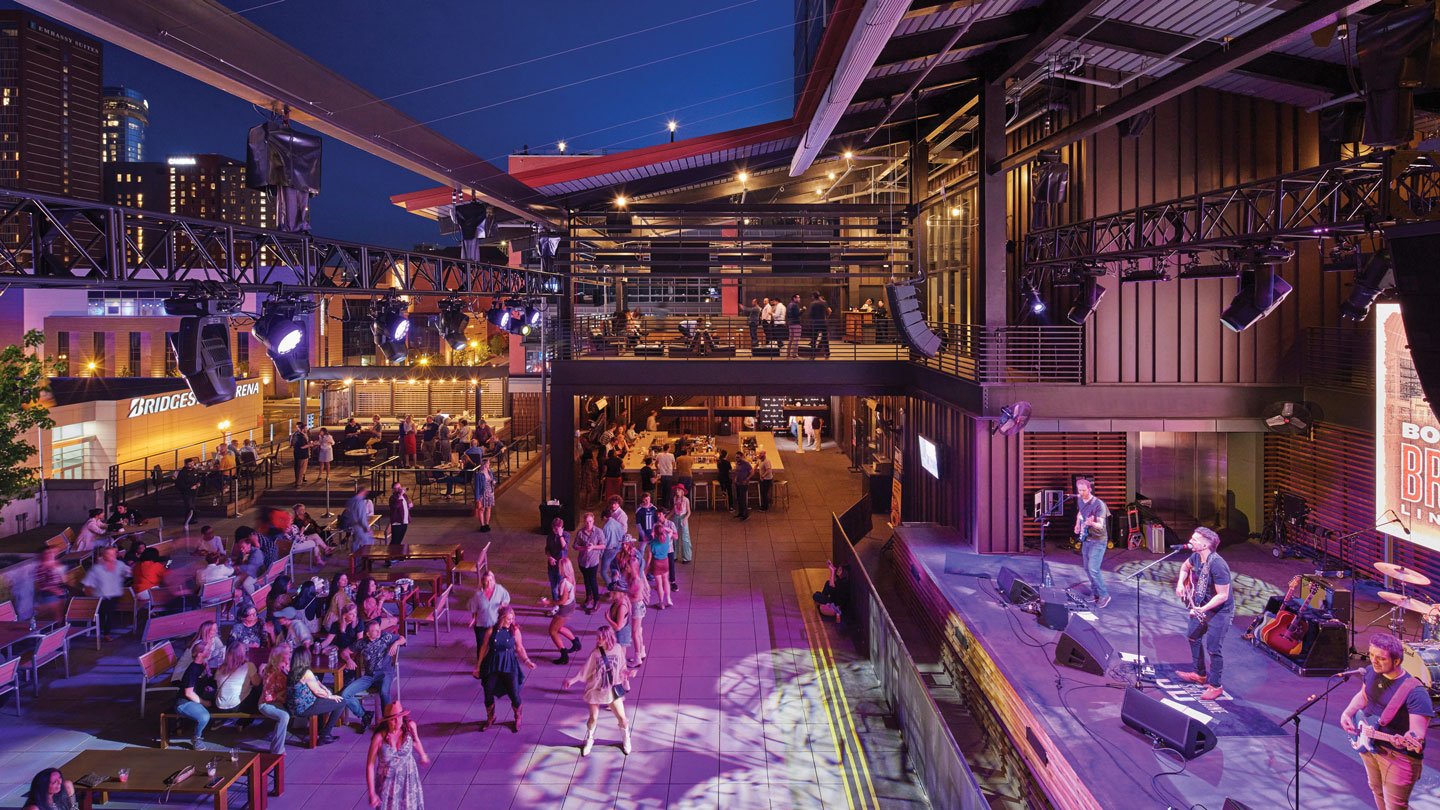
Experiential Retail Helping to Fuel a Brick-and-mortar Revival
Retail spaces are evolving into experience destinations rather than just places to buy goods.
By transforming shopping centers and malls into interactive, immersive and often Instagrammable destinations, mall owners and savvy retailers are offering something that digital platforms can’t replicate: opportunities for genuine human connection and full sensory engagement. In other words, modern experiential retail is providing compelling reasons for consumers to return — in person — to these properties.
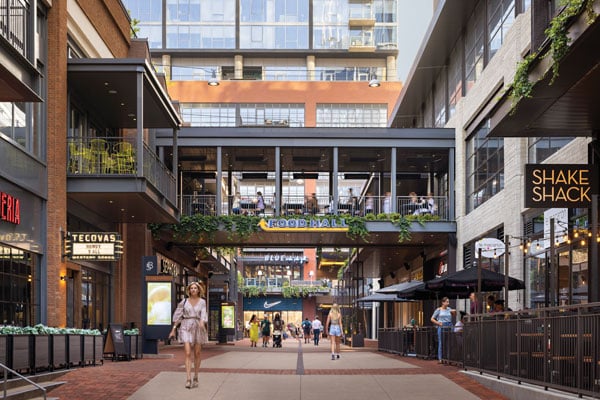
Fifth + Broadway, a mixed-use development located in downtown Nashville, offers almost 240,000 square feet of entertainment, retail and cultural amenities, including a food hall and a music venue with multiple stages. Zack Benson courtesy of Gensler
“Shopping centers today aren’t the malls of the 1980s, that ‘shop till you drop’ era,” commented Holly Rome, executive vice president of retail agency leasing at JLL. “Back then, we spent the whole day at the mall shopping. Now we’re in an environment where people can easily get many things online. Yet [brick-and-mortar] retail remains strong across the board and continues to evolve. One great thing about the business today is the excitement around new offerings, whether product types, unique shopping experiences, restaurants or innovative retail environments. Retail has elevated itself to something much more creative and experiential.”
In the post-pandemic era, retail spaces have evolved from mere places to buy goods to destinations that offer unique experiences. “Brands like Gentle Monster and Restoration Hardware (RW) engage customers through immersive designs and added features like restaurants, making shopping an event,” noted Barrie Scardina, president of Americas retail services at Cushman & Wakefield. “Developers are also focusing on experience-driven tenants to boost foot traffic and foster community connections. We are studying this trend to understand how it shapes the future of consumer engagement in physical stores.”
Generation Z, in particular, is redefining reality, toggling between the digital and physical worlds, said David Glover, mixed-use and retail centers leader at architectural, design and planning firm Gensler. “The fact that ‘manifest’ was Cambridge Dictionary’s Word of the Year speaks volumes — this generation is all about turning ideas into experiences,” he said. “But here’s the irony: While they prefer digital interactions, they’re also navigating a loneliness crisis. The attention economy is shifting from excess to emotional resonance — people want fewer, deeper, more meaningful moments.”
Investing in the Retail Sector’s Potential
Simon Property Group is an Indianapolis-based real estate investment trust with 194 retail properties in 37 states and Puerto Rico and a total of 400 properties in 24 countries. “With more than 2 billion visits to our centers every year, we are seeing how people of all generations continue to crave connections and experiences outside of the home,” said Mark Silvestri, Simon’s president of development.
That is true even for Gen Z, “despite its reputation for being constantly online,” Silvestri asserted. “According to a survey by the International Council of Shopping Centers, 97% of Gen Z consumers shop at brick-and-mortar stores. Gen Z respondents said they value the ability to get items immediately; to see, touch and try out products; not having to pay for shipping; and the opportunity to hang out with friends and enjoy the unique experience of physical stores.”
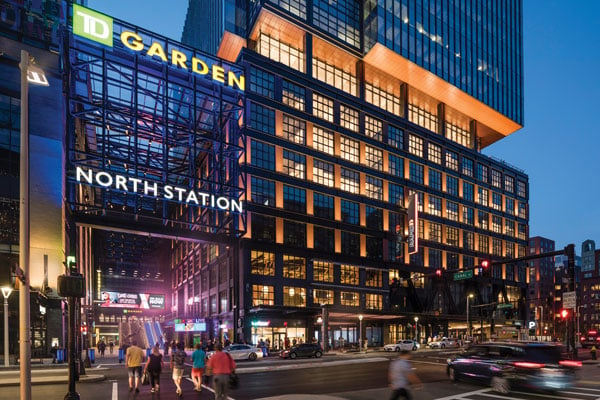
The Hub on Causeway, an approximately 2 million-square-foot mixed-use project designed by Gensler in collaboration with Boston Properties and Delaware North Companies, occupies the original site of the Boston Garden. Now anchored by entertainment destination TD Garden, the development features specialty retailers, high-concept dining, creative office space, and residential and hotel towers. Anton Grassl courtesy of Gensler
Simon is investing $8 billion in upgrading many of its malls. Among its current projects are the following:
At Southdale Center near Minneapolis, Simon is making a major investment that includes luxury apartments; a Homewood Suites by Hilton hotel; and lifestyle-centric brands including Life Time’s resort-style athletic complex, RH Gallery and Rooftop Restaurant, and golf-themed entertainment venue Puttshack. A new, fully leased luxury wing is set to launch at Southdale this year.
Northgate Station in Seattle is a mixed-use, transit-oriented development by Simon that is creating a sustainable live-work-play-stay-shop experience. The redevelopment project features shops, restaurants, 234 luxury apartments (scheduled to open in 2026), Class A office space and 54,000 square feet of communal gathering areas. The $80 million Kraken Community Iceplex, a practice facility and team headquarters of the National Hockey League’s Seattle Kraken, serves as the development’s centerpiece. A new Residence Inn by Marriott hotel will open soon as well.
At Smith Haven Mall in Lake Grove, New York, Simon has launched a multimillion-dollar project that includes several new marquee retailers, plus dining destinations, an outdoor plaza and lifestyle amenities, including Golf Lounge 18, an indoor golf simulation facility that allows players to choose from more than 200 golf courses worldwide. Smith Haven also includes a newer type of amenity for properties that were once focused almost exclusively on shopping: Stony Brook Medicine, providing convenient medical services while people are visiting the mall.
The Rise of Experiential Retail
Experiential retail existed before COVID-19, but the pandemic accelerated its growth significantly. “Before COVID, various forms of experiential retail were nice to have. Now, they are must-haves,” asserted Amanda Ortiz, director of Americas industrial and retail research for CBRE.
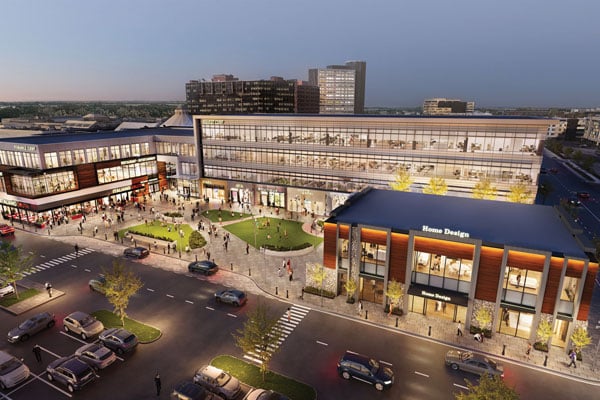
The Fashion Mall at Keystone, a redevelopment in Indianapolis from Simon Property Group, will offer luxury retail and first-to-market dining and entertainment destinations, along with an outdoor plaza and new office space, One Keystone Crossing. Courtesy of Simon Property Group
The pandemic underscored the need people have for greater social connection, Rome said. “[We want] to enjoy great restaurants, sporting events, the simple pleasure of just being with friends,” she said. “We did these things before COVID, but now we appreciate them on another level.” She added that consumers appreciate landlords and retailers that focus on experiential retail, leveraging consumer preferences and adapting their business to differentiate themselves.
“Today, people can shop online for most everything,” Scardina said, “so physical stores must provide compelling reasons to visit — brand experience, personalized customer service and unique, immersive experiences. Omnichannel strategies leverage physical stores to drive online sales and vice versa, also integrating social media engagement. Digital-first brands, like Warby Parker, are a notable example of how strong online services also benefit from in-store interactions.”
Silvestri said that while the mall’s appeal spans generations, how people shop has evolved. “Today’s shopper isn’t choosing between online and in-person shopping,” he said. “They’re using both, often at the same time, in ways that complement one another.” That’s why Simon implemented an omnichannel strategy, launching ShopSimon, a rebranded and expanded online marketplace, last year.
More retailers are now seeking to replicate the brand relationships consumers have online in their physical stores, according to Ortiz. “When tenants look for new spaces, they must now consider experiential aspects such as in-store classes or additional offerings,” she noted.
Identifying the Right Retail Mix
As Scardina explained, when landlords think about expanding revenue at malls and shopping centers, they must consider how to keep people engaged (duration of stay), how to encourage visitors to return (repeat traffic) and how to get people to explore the entire center rather than just one store (cross-traffic). “These challenges require innovative strategies that create engaging, memorable experiences to keep visitors around longer and encourage them to move through the entire space,” Scardina said.
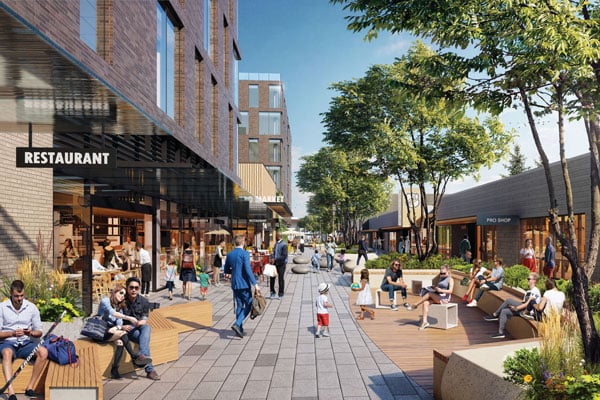
Northgate Station, a transit-oriented development in Seattle by Simon, is creating a live-work-play-stay-shop experience with its mix of retail, restaurants, luxury apartments, Class A office space and communal gathering areas. Courtesy of Simon Property Group
There is no one-size-fits-all version of experiential retail, according to the experts interviewed. Developers and owners must carefully select what needs to be added to the mix at each specific location. “Experiential retail has many layers, from product delivery and customer service to the mix of retail, restaurants, services and boutique fitness — all contributing to the ‘experience,’” Rome noted. “Ambience, safety, parking and logistics are fundamental. You must cater to your [specific] market, which varies greatly. The market in a small town in Iowa differs significantly from that of New York City.”
“At JLL,” Rome continued, “we begin by understanding our market, the consumers, their interests and the gaps in local offerings. Once we have that understanding, we create an experience tailored to the specific market. Ski resorts, for example, require a mix that includes daily needs, sports essentials and leisure shopping. Conversely, a value-conscious center focuses on price and daily community needs. Every location requires a curated selection of retailers. We look at performance data, customer origins, market gaps and the surrounding area’s retail landscape to build the right mix.”
Sports-centric Venues
Stadiums and sports-centric venues have become powerful magnets for retail, leveraging consistent foot traffic generated not only by major sporting events but also day-to-day activities. Successful venues incorporate shopping, dining, entertainment and community spaces, ensuring a sense of vibrancy even outside of game days. To maximize their appeal, these complexes are designed for multifunctional use, attracting visitors through fitness centers, restaurants, family-oriented activities and shopping experiences, transforming them into year-round lifestyle destinations.
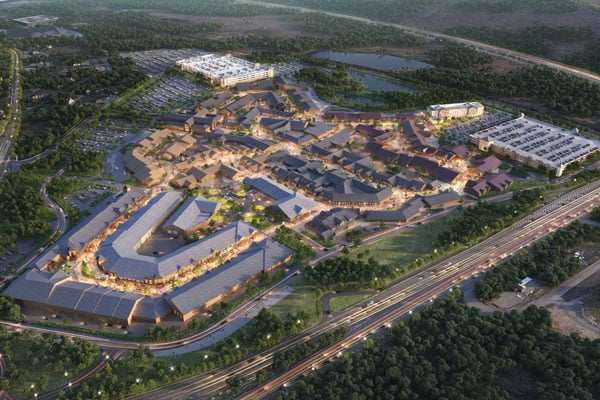
Simon is adding 155,000 square feet of retail stores and restaurants, a 200-key luxury hotel and upgraded customer amenities that include a new children’s play area and a VIP suite to Woodbury Common Premium Outlets in Central Valley, New York. Courtesy of Simon Property Group
“Experiential retail in and around sporting arenas and stadiums has been growing over the past several years,” Scardina said, “but developers need to study traffic, event patterns and community-specific opportunities to ensure success. The neighborhood around the stadium is also important to consider, as are transportation patterns.”
One thing that doesn’t work for retail at such venues is attracting a crowd only when the home team is playing. “Sports-centric venues need to ensure constant weekday use with regular sports training, fitness activities, family gatherings and other consistent uses, in addition to heavily attended events and tournaments,” Rome observed. “Parents dropping kids off frequently appreciate convenient activities nearby, such as shopping, grocery [stores] and restaurants.”
Tech’s Present and Future Role
Technology has been a significant disrupter of conventional retail, particularly with the advent of online shopping and expedited delivery. However, according to those interviewed, it is now playing an equally pivotal role in the reinvention of brick-and-mortar, experiential retail.
Retailers are increasingly blending physical and digital experiences into something marketers are calling “phygital” retail. Technologies that support phygital retail include geolocation devices, beacons, wearable devices, social media, the Internet of Things and smart mirrors. Additionally, there is increasing use of augmented reality and virtual reality.
“Retailers utilize visually appealing technology like augmented reality, but consumer data collection is equally critical,” Ortiz asserted. “Interactive displays attract attention as novel experiences. Retailers will increasingly use collected data to optimize consumer interactions.”
“The biggest disrupter today isn’t just technology — it’s the collision of physical and digital worlds, reshaping how we live, shop and connect,” Glover said. “People assume technology is the answer, but what we really crave is awe, thrill and shared experiences. Technology has turned many [older style] malls into little more than fulfillment centers. To stay relevant, retail spaces must evolve beyond consumption and become platforms for meaningful engagement, where food, wellness, education and social experiences take center stage.”
“The more our lives move online, the more we seek visceral, high-impact experiences in the real world,” Glover continued. “Great spaces don’t just facilitate transactions; they create moments. The best places seamlessly blend retail, social, work and living into one continuous, dynamic experience.”
Attempting to Redefine the Future of Malls
Can experiential retail save old suburban malls that have fallen on hard times? The answer from those interviewed is … it all depends. Experiential retail might offer a lifeline if the mall can integrate unique, engaging experiences, including entertainment venues, immersive dining and community-centric events, helping to attract new audiences and secure renewed relevance in a digitally dominated retail landscape.
“The malls that survive will be the ones that reinvent themselves,” Glover said. “The high-performing ones will double down on experience and placemaking. Others will pivot, turning into mixed-use urban hubs with a blend of residential, retail, office and entertainment. The era of the mall as we knew it is over, but the opportunity to redefine these spaces is just beginning.”
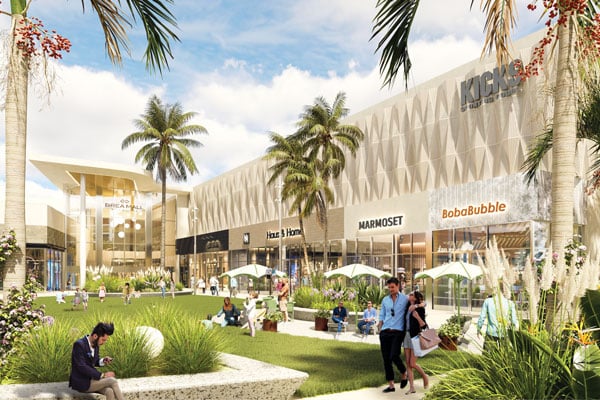
Simon’s redevelopment of Brea Mall in California features 119,000 square feet of retail brands, eateries, entertainment destinations, an athletic club and 380 new luxury apartments with plaza views. Courtesy of Simon Property Group
The future of any specific mall largely depends on its location, condition and market potential, according to those interviewed. Premium locations may justify major redevelopment or partial demolition to create mixed-use spaces that integrate housing, offices and retail. Success relies on understanding local market demands, collaborating closely with city officials, securing appropriate financing and strategically rethinking property uses to align with community needs.
Scardina of Cushman & Wakefield emphasized the need for careful analysis: “Developers must analyze trade areas — how far consumers travel, local demographics, existing businesses — to avoid duplication. Mixed-use developments require an understanding of both resident and community needs, considering factors such as traffic and parking. Developers, including Edens, Kimco, Jamestown, Brookfield, Westfield, Simon and Tanger are introducing experiential retail into their developments to increase consumer engagement and expand the centers’ performance.”
She further suggested that some malls may require only cosmetic updates rather than complete redevelopment. When located in engaged communities with sufficient population and income, these malls may present excellent investment opportunities. “Grocery-anchored shopping centers thrived during the pandemic and remain attractive investments today,” she said. “Developers are adding health, wellness and cosmetics brands as well as boutique gyms to further engage consumers. Developers are analyzing community needs to drive traffic, duration and repeat visits. This strategy helps to enhance property values.”
Cost of Experiential Retail
Integrating experiential retail can significantly enhance consumer engagement and the long-term profitability of a development. However, these types of projects typically involve considerable upfront investments.
“Cost is a major challenge,” Rome acknowledged. “Delivering experiential retail, elevated designs, landscaping and marketing is expensive. However, research indicates many consumers, particularly millennials and Gen Z, are willing to pay a premium for quality, creating long-term value.”
Glover emphasized the complexity of developing experiential retail spaces. “Developers navigate a maze of zoning, environmental challenges and infrastructure costs, but those who get it right drive value. In a world where retail is increasingly commoditized, the most successful places don’t compete on price, they compete on experience.”
Local Government Can Help
Local government can be instrumental in the success of experiential retail projects. Rather than serving merely as regulatory entities, they can act as collaborative partners that are deeply invested in community revitalization. By streamlining zoning processes, offering incentives and fostering cooperative relationships with developers, municipalities actively support projects that promise economic growth and increased foot traffic. This collaborative approach can significantly shorten development timelines and ensure projects align with community aspirations.
“Generally, local government is receptive and excited because these projects represent investment in the community and enhance the quality of life for residents,” Rome said. “Our research shows many consumers strongly prefer experiences in their leisure activities, and cities recognize that to remain relevant, they need to provide these experiences.”
Glover shared a similar vision, emphasizing the centrality of community: “Developers and local governments need a relationship built on trust, not transactional approvals. The best projects happen when developers truly listen, engage and integrate local needs rather than just ticking boxes.”
Scardina underscored the complexities involved in such partnerships: “Every community is unique, but generally we see a wide range of collaboration between developers and local governments. There are numerous considerations, including zoning, impact on traffic patterns and end use for the area under development. These projects can be complex for the developer and the local government, but they often lead to strong outcomes for the community.”
Future Trends
What will experiential retail look like in the future?
“The future belongs to spaces that multitask,” Glover said. “Successful places aren’t just where you shop or eat — they’re where you live, work and play. The best-designed spaces respect people as multifaceted individuals, not just consumers. But content is king — if you’re not continuously activating the space, you’re losing relevance. The future is local, immersive and human-centered. Public spaces are becoming the new town squares, fostering community traditions and social cohesion in ways we haven’t seen in decades.”
Ron Derven is a contributing editor to Development magazine.
|




